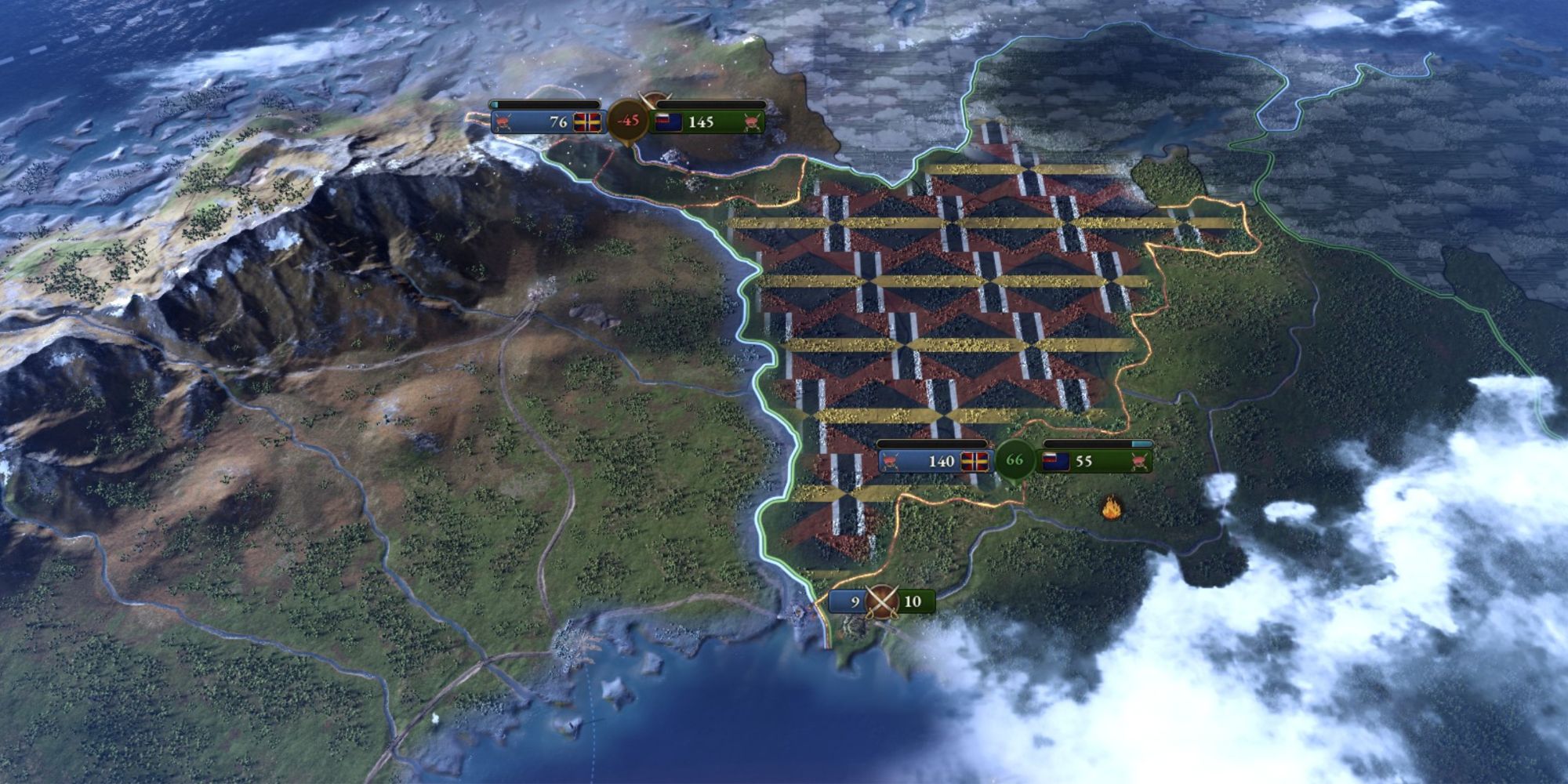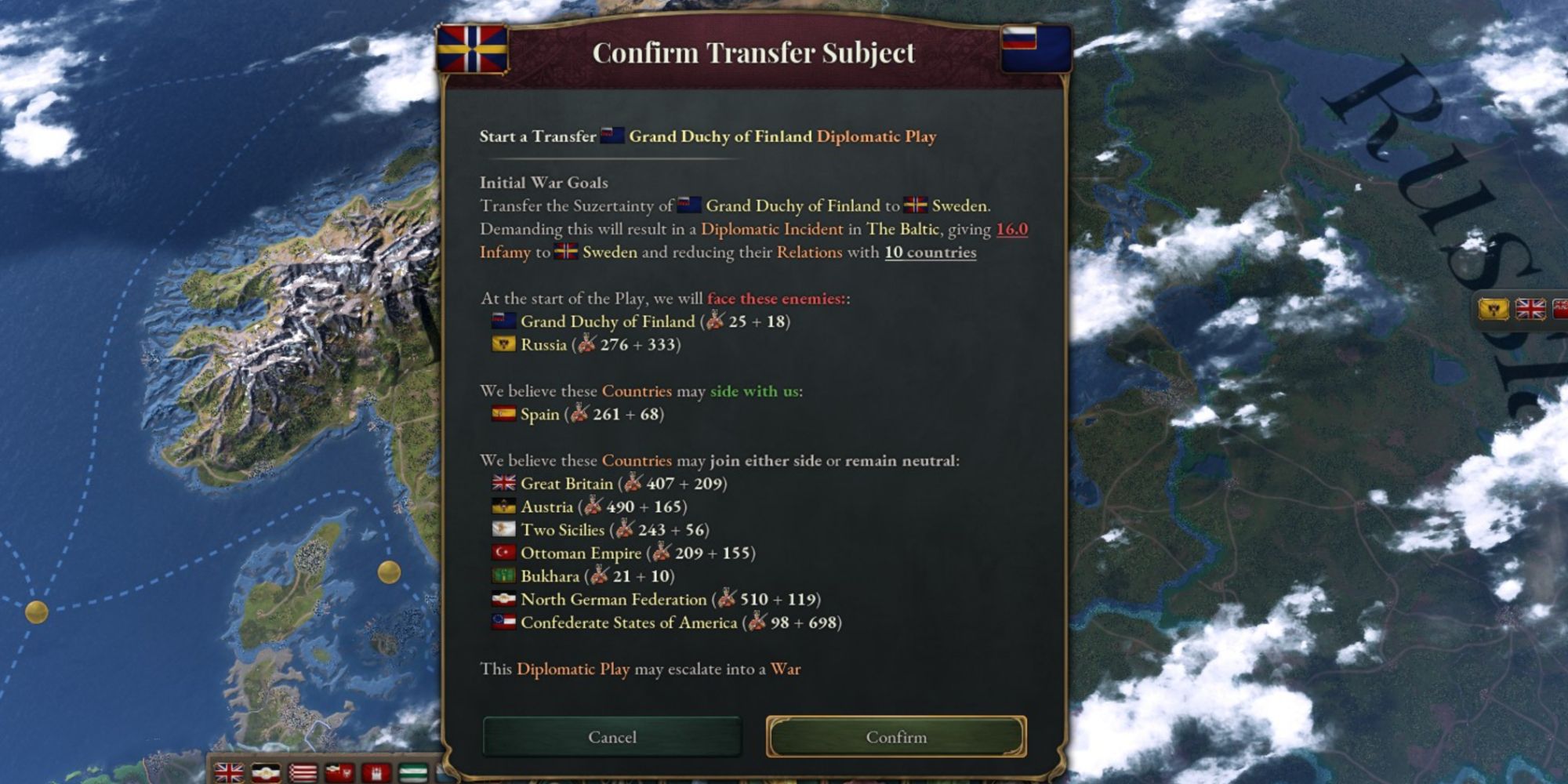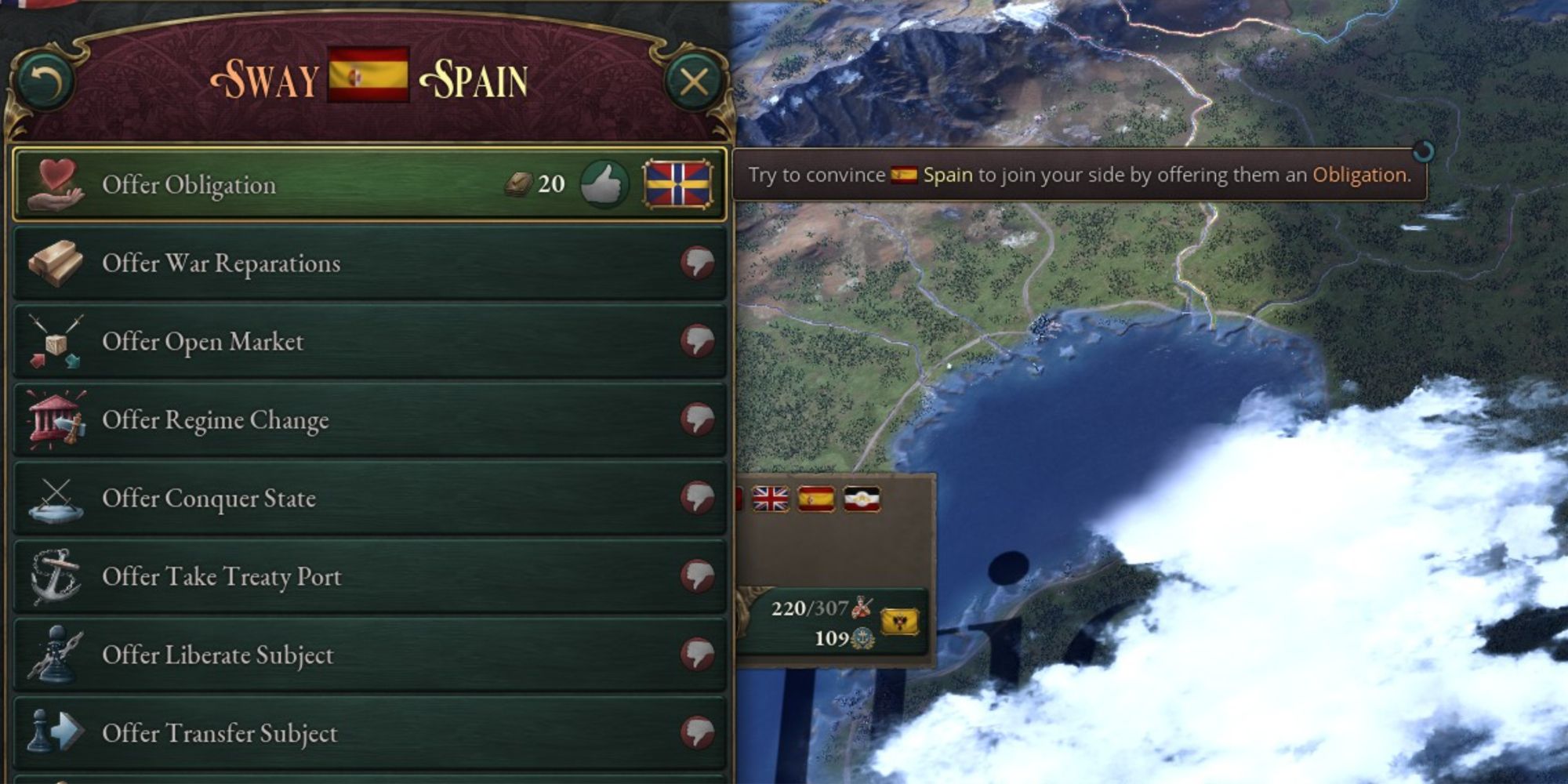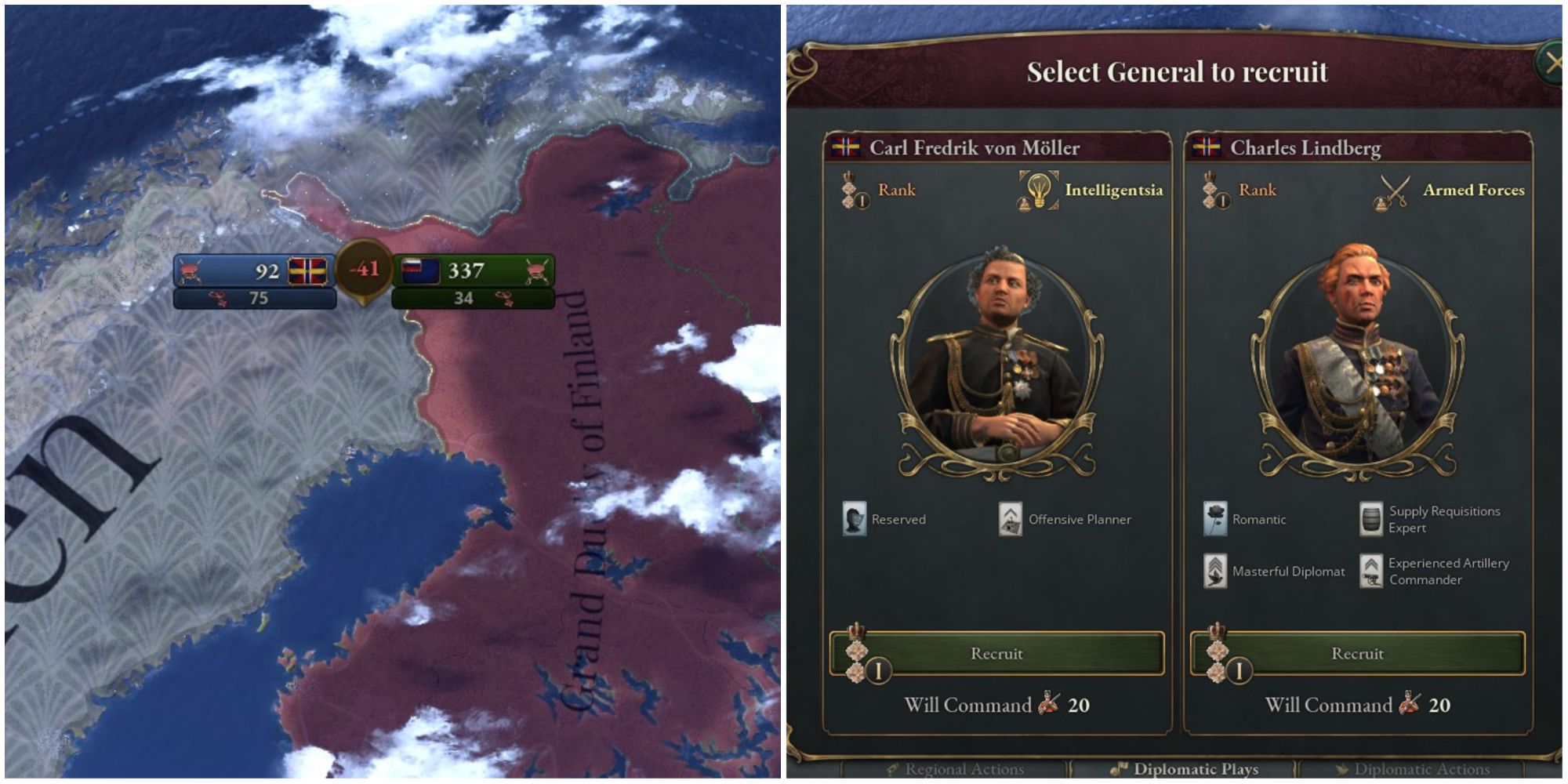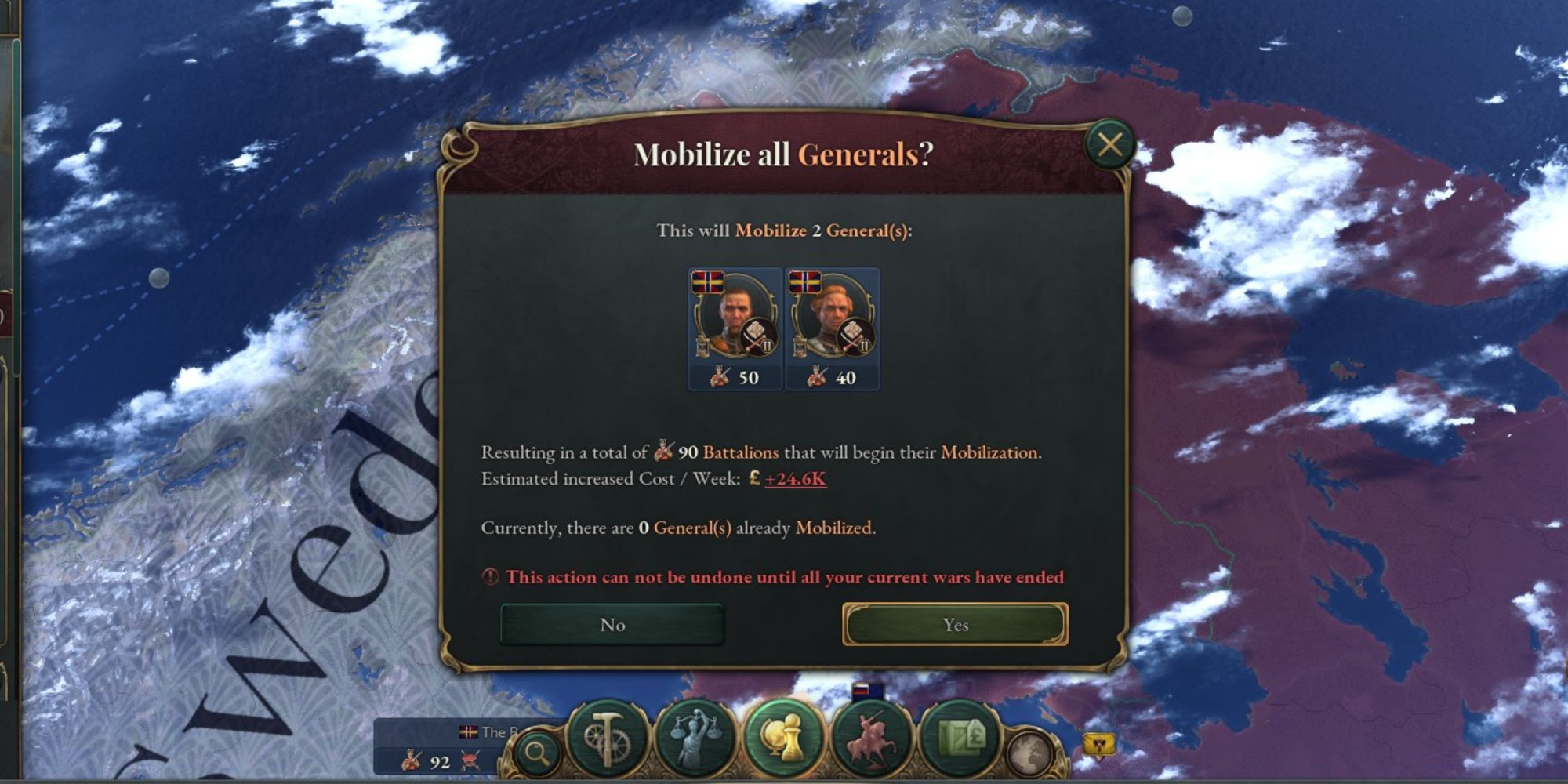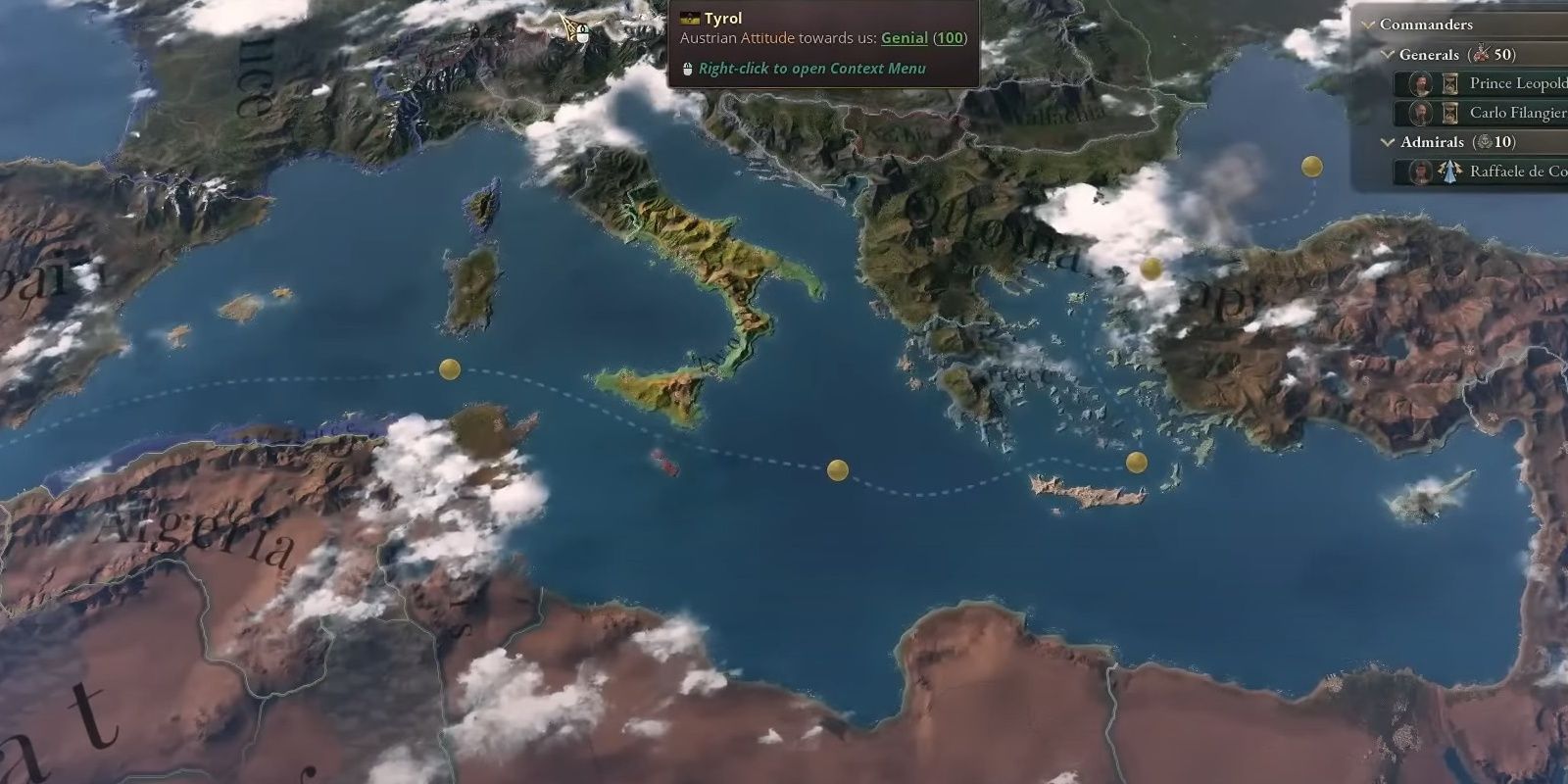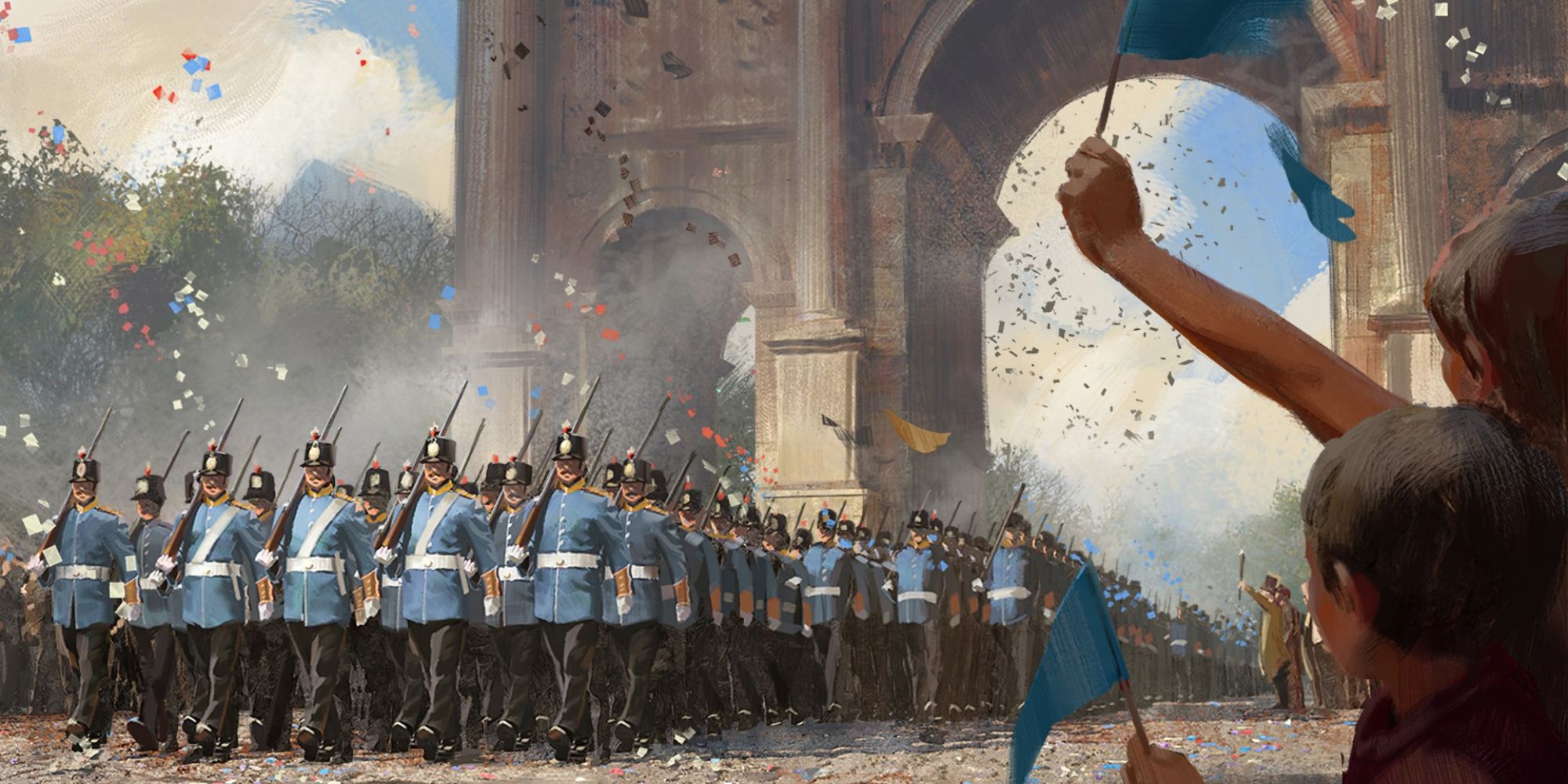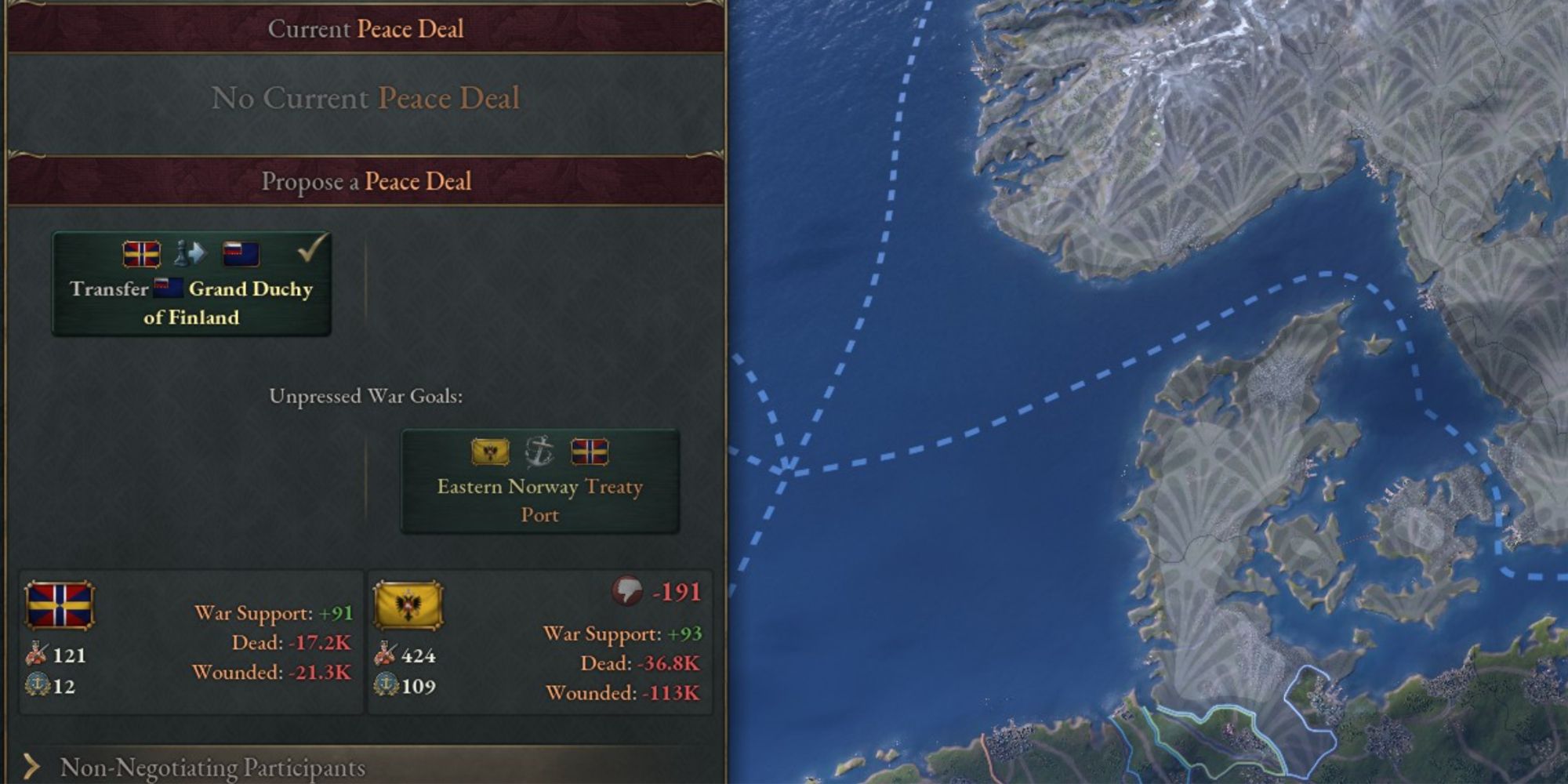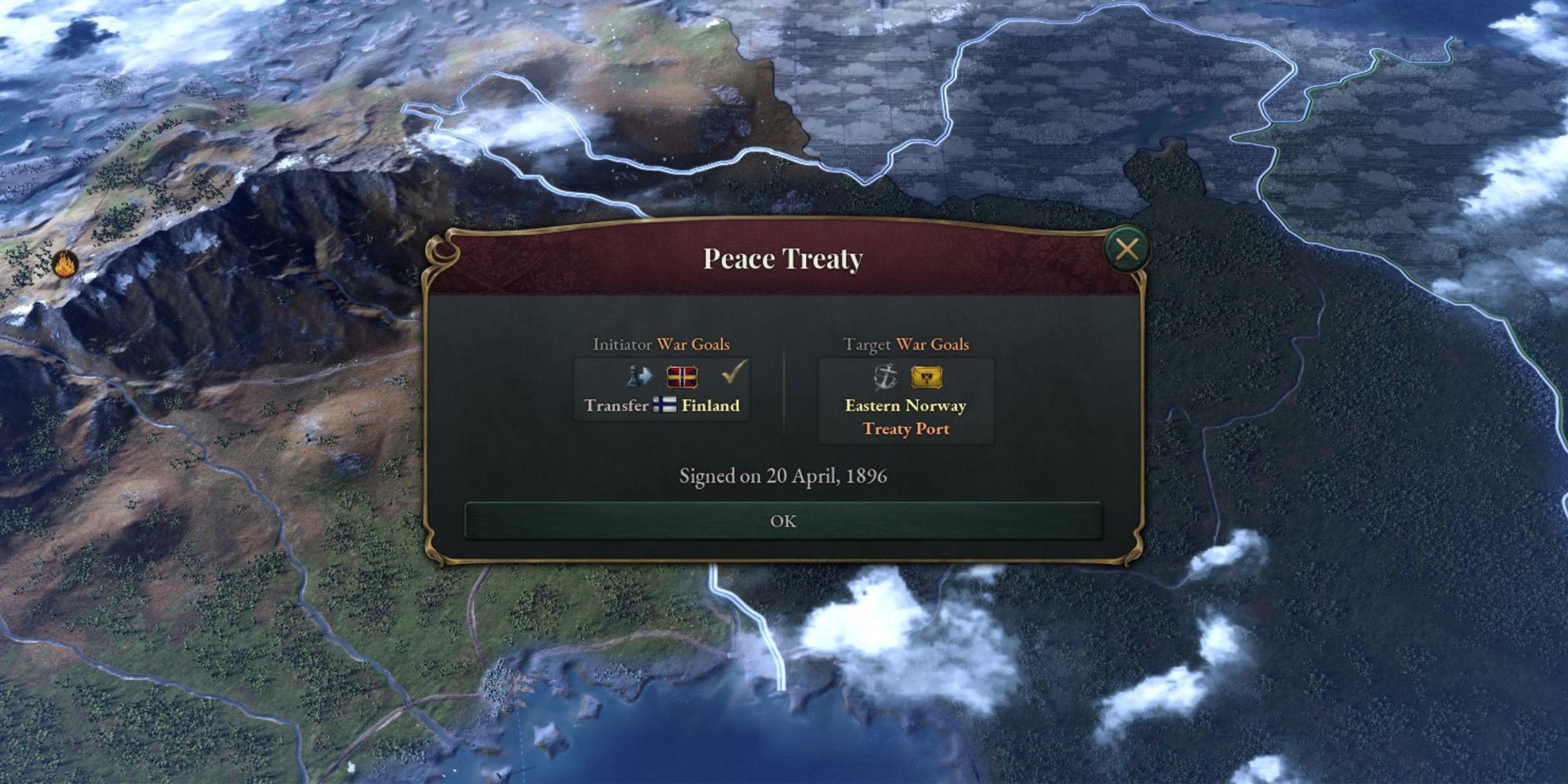Quick Links
While warfare isn't one of Victoria 3's main selling points, it's still a very important factor in the game. Most countries will end up at war sooner or later, whether it's to grow their empire or to defend their borders from antagonistic neighbors.
As you might expect, warfare is just as complex in Victoria 3 as many of its other mechanics. You have to manage your Generals and Battalions, enact laws that make your military stronger, and push warfronts with some strategy if you want to fight your way to success.
Updated on November 27, 2023 by Matt Arnold: Warfare in Victoria 3 received an overhaul alongside the Colossus of the South DLC. We've added a section on army composition to help you get the most out of your new troop types and battalions! We've also updated the section on naval warfare, so that Britannia - or whomever else you happen to play - can rule the waves.
Diplomatic Plays - AKA, How To Start A War
In Victoria 3, it is not possible to declare war outright. Instead, you must make a Diplomatic Play. Think of these as formal threats on a global stage in which you put your military might up against another nation, everyone with an interest in the region knows about it, and they can interfere at will.
The type of Diplomatic Play that you use to begin a conflict will affect what happens if your play is successful. Note that using different Diplomatic Plays will incur an infamy penalty, which will make the other countries with an interest in the same region like you less.
The table below details every Diplomatic Play and the outcomes they will cause:
|
Diplomatic Play |
Effect |
|---|---|
|
Annex Subject |
The conquered vassal becomes a part of your country. You cannot annex puppets or dominions. |
|
Ban Slavery |
Slavery is forcibly banned in the target country. |
|
Conquer State |
The states being targeted become a part of your country. |
|
Cut Down To Size |
Any states and subjects conquered by the target country over the last ten years are released. |
|
Humiliate |
Reduces the target country's prestige and prevents them from making Plays against you for a number of years. |
|
Independence |
Your country breaks free from its overlord. |
|
Liberate Subject |
You break the target free from its overlord. |
|
Make Dominion |
The target country becomes your dominion. A dominion is a subject that doesn't have to join its overlord's wars but pays them 10% of its weekly treasury income. |
|
Make Puppet |
The target country becomes your puppet. A poppet is a subject that has to join its overlord's wars and pays them 20% of its weekly treasury income. |
|
Make Vassal |
The target country becomes your vassal. A vassal is a subject that has to join its overlord's wars and pays them 15% of its weekly treasury income. |
|
Open Market |
Forcibly changes the target's trade laws to Free Market. |
|
Regime Change |
Forcibly changes the target's government and laws to match your own. |
|
Return State |
Returns the chosen states to your country - can only be used on states that consider your country their rightful home. |
|
Take Treaty Port |
The chosen country cedes a Treaty Port to you - Treaty Ports open up trade between your countries and let you bypass tariffs. |
|
Transfer Subject |
Forces the target country to give you overlordship of the target subject. |
That part about interest and regions is important, by the way - you can only make Diplomatic Plays in strategic regions in which you have declared an interest. The number of regions you can do this in depends on your prestige and power ranking, and some actions require that you have a sustained interest. In other words, it must have been declared for some time.
You won't go to war upon making a Diplomatic Play - instead, you'll enter the Escalation process.
Escalation And Maneuvers
Once you have chosen a Diplomatic Play, a countdown begins, and a new menu will be available on the right-hand side of the screen with a circle that fills over time. There are three stages to this process:
- Escalation, in which it is possible to add more war goals to the conflict. The war goals available will depend on the target country, with most of them matching the various Diplomatic Plays you could have made against them. War Reparations is a popular war goal that forces the country to pay you for a period of time after losing the war, but you can't make a Diplomatic Play for this alone.
-
Diplomatic Maneuvers is the next, and longest phase. In this stage, it's time to sway other countries to your side. In the Sway tab, you can see where countries lean based on their position in the menu - those on your side are likely to join your side of the war even if you don't promise them anything. You can also see their army sizes here, showing you how valuable they can be in a war.
- To sway a country, click on them in the Sway tab and then choose an option that has a green thumbs-up symbol next to it. Once chosen, you'll have to wait while they consider the offer. If they accept, they'll join your side in the war officially.
- Offering Obligations is an easy way to get people on your side, but be wary of this. Obligations can backfire, as countries may oblige you to join in their wars.
- It is possible to sway a country that has already pledged itself to your opponent's side. If accepted, they become neutral - they will not join your side.
- Once the Maneuvers stage is over, there is a short Countdown to War. At this stage, either side can Back Down - this will surrender the war goals in their entirety, but prevent the need for blood loss and economic destruction. AIs are likely to Back Down if you have an overwhelming advantage against them.
Adding war goals and attempting to sway countries to your side during this process costs Maneuvers. The number of Maneuvers you get to work with depends on your power rank and prestige. Be aware that both war goals and sway attempts use the same pool of Maneuvers, so adding lots of war goals will mean less chances to get more allies.
If you promise a war goal to an ally to get them to join the war, be aware that you'll have to make good on this in the peace treaty. If you don't there may be diplomatic repercussions.
An Introduction To Warfare
If neither country backs down during a Diplomatic Play, war begins. In Victoria 3, war isn't decided by moving stacks of soldiers - instead, there are moving warfronts to manage. Warfronts appear organically where the opposing countries meet, and both send their troops to clash there.
When one side is victorious at a warfront, the warfront gets pushed back further into the losing side's country, allowing the victor to make ground and win warscore. Winning battles and taking land will improve your country's standing in the war, and your opponent will lose standing, becoming more willing to accept a peace deal or capitulate outright.
Generals And Battalions
To actually fight in a war, you will need two things: Generals and Battalions.
Generals are recruited in the Military menu and are necessary to lead your soldiers into battle. If a soldier is garrisoned and not assigned to a General, they simply do not get to participate in a war.
- Hiring and promoting Generals costs a certain amount of Bureaucracy, so be wary of your balance before starting or escalating a conflict.
-
Generals can only support and lead a certain number of troops - if you want them to lead more, you'll need to Promote them. To do this, click on their portrait in the Military menu to open up their detailed menu and Promote them from there.
- Be wary that Promoting a General will increase the political power of any Interest Groups that they are a part of.
Generals all have traits - taking a look at these traits may help you decide where to mobilize them and which tactics to use. For example, a General with Expert Offensive Planner will obviously have greater success when using offensive tactics and Advancing Fronts.
Battalions are recruited at the Barracks building, with one Battalion arising from each fully-staffed level of Barracks. The production methods used in your Barracks will affect the quality of your soldiers, so be sure they're well-supplied and up to date when you start a war.
If you have laws that enable Conscription, you will also have access to Conscription Battalions during war. These must be enabled individually in the Military menu, with Conscripts joining the forces of any available Generals.
Conscription Centers pop up during Diplomatic Plays - this is when you should change up their production methods to get better results from Conscripts.
Battalions and Generals are location-based - you will only be able to mobilize Battalions in strategic locations once you've recruited a General there. For this reason, it's a good idea to consolidate your military development into a few, select regions - this is only relevant if you have quite a large country, of course.
The Frontline
To see which frontlines are currently active, you can either look for them on the map or click on the War Overview menu on the right-hand side of the screen. This will give you a quick look at how many Battalions you have stationed there and what your general chances of victory at that front are.
You will need to mobilize your troops when war breaks out. Do this from the Military menu and pick the warfront that you want each General to move towards - note that it will take a period of time before they arrive, so do this sooner rather than later. You can mobilize Generals before war breaks out, during Diplomatic Maneuvers.
After a certain amount of time has elapsed at a warfront, battles will start happening. This will pit Generals against each other, with their Battalions doing all the fighting. You can watch the battle's progress by clicking on it in the Warfront Overview menu.
Naval Warfare
Similarly to Generals and Battalions, coastal countries have access to Admirals and Flotillas. Admirals are recruits just like Generals and have the same qualities and limitations, while Flotillas are recruited from Naval Bases in the same way that Battalions come from Barracks.
Unlike armies, navies can be deployed to a specific Sea Zone even if you aren't at war, and they are always considered mobilized. A navy will patrol their assigned zone until they come into contact with enemy ships, preying on Convoys in the meantime.
A navy that loses a battle at sea must return to a friendly HQ for repairs, and will be unavailable for deployment until they're patched up.
Navies can also be used to transport armies via the Naval Invasion action. The army will travel with the navy to their destination and attempt a landing as long as there are no enemy flotillas in the same Sea Zone. Once the navy has driven off any blockading ships, the army will commence a battle on the shore.
If the invading army wins and successfully takes ground, they will open a new front that other armies can join without also having to perform a Naval Invasion. If they lose, they'll instead return to the fleet and try again after they recover.
An army making a Naval Invasion takes severe combat penalties if they have more battalions than their escorting flotilla - be sure your ships are up to the task!
Army Composition
Starting with the Colossus of the South update, battalions can be one of three types; infantry, artillery, and cavalry. Each has a specific battlefield role, and having a strong build for your armies can turn the tide of battle.
- Infantry is the most common battalion type, and primarily consume Small Arms and Ammunition. They are important for maintaining your army's staying power as they contribute the most to Organization and Manpower.
- Artillery is your heavy damage-dealing battalion, especially when you're defending. They increase the Kill Rate of their formation, inflicting more casualties on the enemy to erode their Morale in the short term and War Support in the long term. Attacking into an army with lots of artillery will always be a costly maneuver.
- Cavalry are decently strong on offense, but they lose Morale quickly. Their main advantage is that they make it more likely that their army will capture territory after winning an offensive battle. Even a few cavalry battalions can shorten a war by reducing the need to fight the same battles over and over.
An army's combined number of cavalry and artillery battalions cannot exceed the number of infantry battalions, or else the army will lose Organization the same way as if they had a General without enough Command.
Peace Deals
There are three ways to end a war:
- Propose a successful peace deal or accept one from your foe.
- Propose a successful white peace or accept one from your foe.
- Capitulate, or have your enemy capitulate.
To propose a peace deal, click on the War Overview and then head to the Make Peace tab. Here, you'll find the applicable war goals. Click on any unpressed war goals to press them, which sets the details of your proposed peace deal.
Note that you can agree to some or all of your foe's war goals, as long as they don't directly interfere with your own. This will make them more likely to accept the peace deal, as you can tell from their acceptance level next to their flag.
A white peace is simply a peace deal with no war goals pressed. For an AI to accept this, the war has to be devastating enough to make them really want an end to it.
Capitulation means accepting every war goal against you, including the unpressed ones. A sufficiently devastated enemy AI player will capitulate, ending the war immediately.
When a peace deal is reached, an information box will pop up showing you every war goal that was in play. Only the war goals with check marks next to them have been resolved, though!
Warfare Tips - AKA, How To Win A War
There's not really a lot of micromanagement required in Victoria 3 - success in war will require more forward planning than fast reactions.
-
Having allies and a good diplomatic standing will allow you to secure more allies during the opening phases of a Diplomatic Play.
- That said, don't rely on AI allies to win wars for you. Always consider that they may have their own problems preventing them from mobilizing their entire army, or they may have other problems. Their huge armies may not be updated, for example.
- While army quality is important, having huge numbers of soldiers is always a good shout. Consider building lots of Barracks before a large war and enacting laws that let you mass-conscript your civilians. If a war is that important, it'll be worth the short-term deficits in money and happiness.
- If fighting a war against a large coastal country, use naval invasions to force them to fight on multiple fronts. If you have the numbers advantage, pushing one front massively while distracting much of their army with the other is a great way to gain ground quickly.
- Events will pop up during wars a lot, often forcing you to choose between different negatives. We recommend avoiding troop recovery maluses - troop recovery is very important in protracted wars.
- Don't neglect the running of your country during a war. You'll likely have trade to sort out, radicalism to keep an eye on, and supply line issues to deal with. If you let these fall to the wayside, you may start losing the money that you need to run the war.

